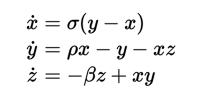Escribir fórmulas matemáticas en libros electrónicos¶
El visor de libros de calibre tiene la capacidad de mostrar fórmulas matemáticas incrustadas en libros electrónicos (archivos EPUB y HTML). Puede escribir las fórmulas directamente con TeX, MathML o ASCIIMath. El visor de calibre usa la excelente biblioteca MathJax para procesar las fórmulas. Esto es un breve cursillo para crear libros con fórmulas que funcionen con el visor de calibre.
Un archivo HTML sencillo con fórmulas¶
Puede escribir fórmulas matemáticas directamente en el texto de un archivo HTML sencillo y el visor de libros de calibre las mostrará con una composición matemática adecuada. En el ejemplo de abajo, usamos la notación de TeX para las fórmulas. Verá que puede usar las órdenes normales de TeX, con la pequeña precaución de que los signos &, < y > deben escrbirse como &, < y > respectivamente.
El primer paso es informar a calibre de que este documento contiene fórmulas. Para ello se añade el siguiente fragmente do código a la sección <head> del archivo HTML:
<script type="text/x-mathjax-config"></script>
Eso es todo, ahora ya se pueden escribir formulas igual que se haría en un archivo .tex. Por ejemplo, éstas son las ecuaciones de Lorentz:
<h2>The Lorenz Equations</h2>
<p>
\begin{align}
\dot{x} & = \sigma(y-x) \\
\dot{y} & = \rho x - y - xz \\
\dot{z} & = -\beta z + xy
\end{align}
</p>
Este fragmento aparece como la siguiente captura de pantalla en el visor de calibre.

Las ecuaciones de Lorentz¶
El archivo HTML completo, con más ecuaciones y fórmulas en el texto se reproduce más abajo. Puede convertir este archivo HTML a EPUB con calibre para obtener un libro electrónico fácilmente distribuible a otras personas.
Éste es el archivo EPUB generado:
<!DOCTYPE html>
<html>
<!-- Copyright (c) 2012 Design Science, Inc. -->
<head>
<title>Math Test Page</title>
<meta http-equiv="content-type" content="text/html; charset=UTF-8" />
<!-- This script tag is needed to make calibre's ebook-viewer recpgnize that this file needs math typesetting -->
<script type="text/x-mathjax-config">
// This line adds numbers to all equations automatically, unless explicitly suppressed.
MathJax.tex = {tags: 'all'};
</script>
<style>
h1 {text-align:center}
h2 {
font-weight: bold;
background-color: #DDDDDD;
padding: .2em .5em;
margin-top: 1.5em;
border-top: 3px solid #666666;
border-bottom: 2px solid #999999;
}
</style>
</head>
<body>
<h1>Sample Equations</h1>
<h2>The Lorenz Equations</h2>
<p>
\begin{align}
\dot{x} & = \sigma(y-x) \label{lorenz}\\
\dot{y} & = \rho x - y - xz \\
\dot{z} & = -\beta z + xy
\end{align}
</p>
<h2>The Cauchy-Schwarz Inequality</h2>
<p>\[
\left( \sum_{k=1}^n a_k b_k \right)^{\!\!2} \leq
\left( \sum_{k=1}^n a_k^2 \right) \left( \sum_{k=1}^n b_k^2 \right)
\]</p>
<h2>A Cross Product Formula</h2>
<p>\[
\mathbf{V}_1 \times \mathbf{V}_2 =
\begin{vmatrix}
\mathbf{i} & \mathbf{j} & \mathbf{k} \\
\frac{\partial X}{\partial u} & \frac{\partial Y}{\partial u} & 0 \\
\frac{\partial X}{\partial v} & \frac{\partial Y}{\partial v} & 0 \\
\end{vmatrix}
\]</p>
<h2>The probability of getting \(k\) heads when flipping \(n\) coins is:</h2>
<p>\[P(E) = {n \choose k} p^k (1-p)^{ n-k} \]</p>
<h2>An Identity of Ramanujan</h2>
<p>\[
\frac{1}{(\sqrt{\phi \sqrt{5}}-\phi) e^{\frac25 \pi}} =
1+\frac{e^{-2\pi}} {1+\frac{e^{-4\pi}} {1+\frac{e^{-6\pi}}
{1+\frac{e^{-8\pi}} {1+\ldots} } } }
\]</p>
<h2>A Rogers-Ramanujan Identity</h2>
<p>\[
1 + \frac{q^2}{(1-q)}+\frac{q^6}{(1-q)(1-q^2)}+\cdots =
\prod_{j=0}^{\infty}\frac{1}{(1-q^{5j+2})(1-q^{5j+3})},
\quad\quad \text{for $|q|<1$}.
\]</p>
<h2>Maxwell's Equations</h2>
<p>
\begin{align}
\nabla \times \vec{\mathbf{B}} -\, \frac1c\, \frac{\partial\vec{\mathbf{E}}}{\partial t} & = \frac{4\pi}{c}\vec{\mathbf{j}} \\
\nabla \cdot \vec{\mathbf{E}} & = 4 \pi \rho \\
\nabla \times \vec{\mathbf{E}}\, +\, \frac1c\, \frac{\partial\vec{\mathbf{B}}}{\partial t} & = \vec{\mathbf{0}} \\
\nabla \cdot \vec{\mathbf{B}} & = 0
\end{align}
</p>
<h2>Inline Mathematics</h2>
<p>While display equations look good for a page of samples, the
ability to mix math and text in a paragraph is also important. This
expression \(\sqrt{3x-1}+(1+x)^2\) is an example of an inline equation. As
you see, equations can be used this way as well, without unduly
disturbing the spacing between lines.</p>
<h2>References to equations</h2>
<p>Here is a reference to the Lorenz Equations (\ref{lorenz}). Clicking on the equation number will take you back to the equation.</p>
</body>
</html>
Nota
El visor de libros electrónicos de calibre admite MathML así como TeX, pero debe incluir la línea <script type="text/x-mathjax-config"></script> en el archivo HTML para que se muestre el MathML.
Más información¶
Puesto que el visor de libros de calibre usa la biblioteca MathJax para mostrar las fórmulas, el mejor lugar para encontrar más información sobre fórmulas matemáticas en libros electrónicos y obtener ayuda es la página web de MathJax.
